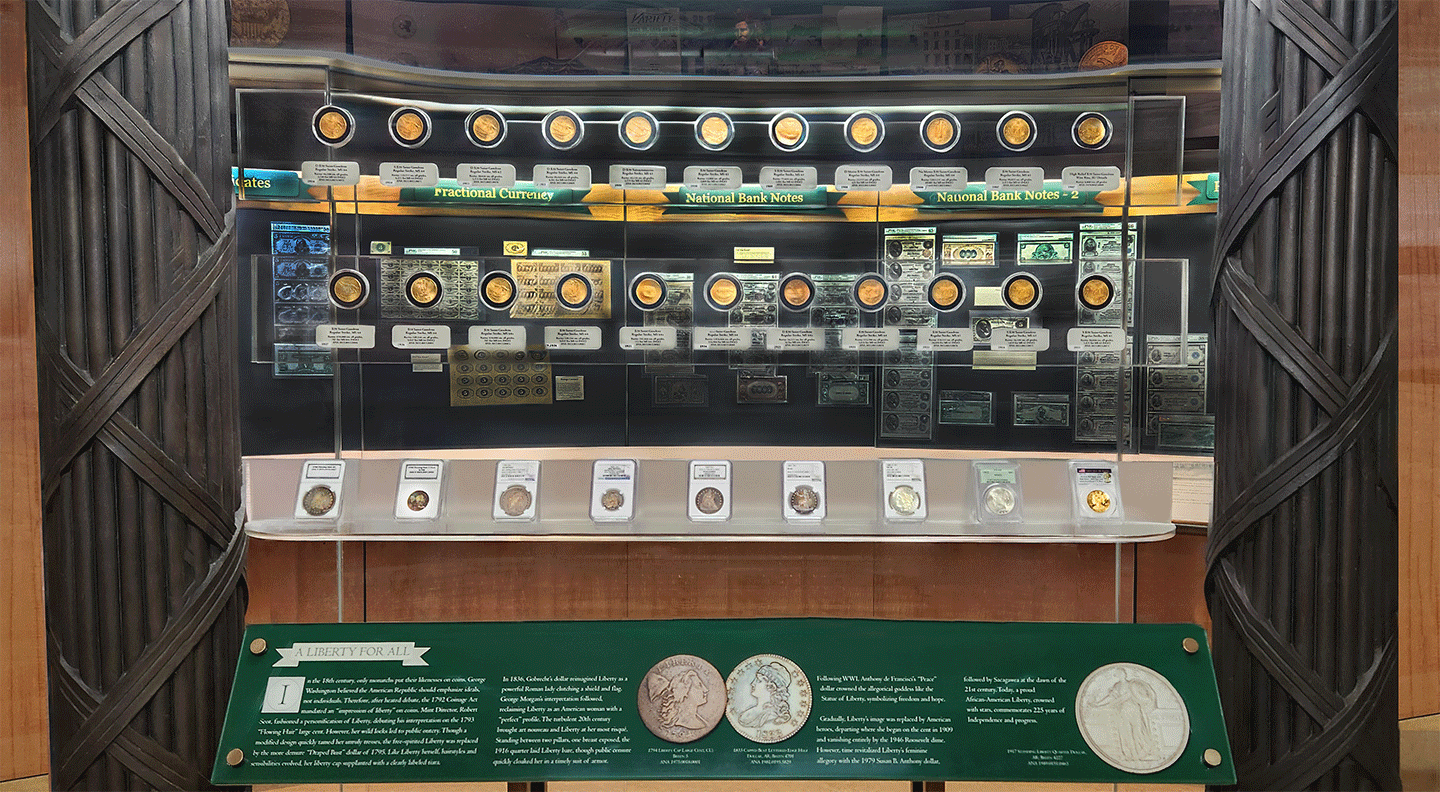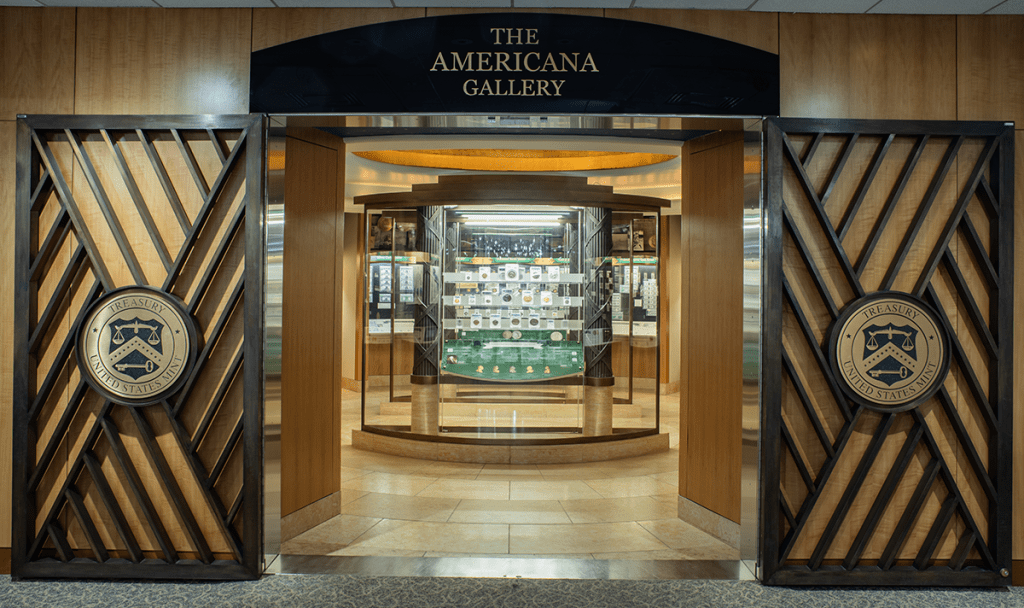
Americana Gallery Highlights
The Americana Gallery presents iconic rarities of American numismatics alongside more accessible pieces to inspire new and seasoned collectors. Prized treasures, such as the 1933 eagle (gold $10); a rare 1855 Wass, Molitor & Company $50 California Territorial Gold piece; and a beautiful set of 1915 Panama Pacific Exposition commemoratives, are peerless presentations of American numismatic excellence. Rare uncut paper money sheets from the famous Aubrey and Adeline Bebee collection demonstrate America’s determination to secure economic security through paper currency. Selections from the Baker-Manley collection of Washington medals, as well as federal and territorial gold coinage from the Carlson Chambliss donation enhance America’s inspiring monetary narrative.
AUDIO COMPANION
Welcome
Discovery of the New World
The Americana gallery begins with the exploration and exploitation of the New World. As soon as the Spanish discovered silver and gold, a pattern of international trade developed based on precious metals. Extracted as cheaply as possible, they were then shipped to the East in exchange for luxury goods like silk, spices and china. The desire for gold soon lured other European powers, who battled for control of the first global trading network. Subsequent colonization enabled nascent western European nation-states to rise to world dominance through military and economic advancements. Unfortunately for the English colonists, precious metals were lacking on the east coast of North America, leading to a remarkably complex numismatic history that mirrors the saga of the United States itself. Choose a case below to begin exploring the exhibit.
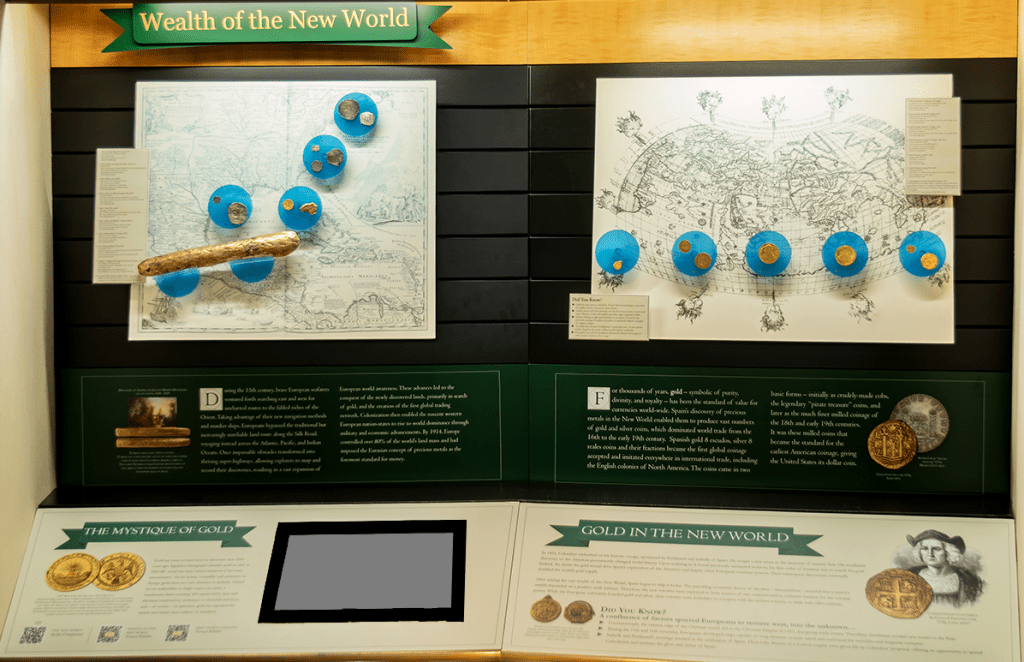
American Gold
When the founding fathers formed the United States from the bickering former English colonies, they needed to forge a sense of national identity. A unified national currency was an ideal solution – improving the economy by eliminating the competing colonial currencies (based on the English pound), and simultaneously fostering a sense of national unity. However, the eastern half of North America lacked deposits of gold or silver at a time when gold and silver coins were the most acceptable trade currency. Undeterred, America forged ahead, constructing the first United States Mint in 1792. Though shortages of specie continued to plague the U.S. Mint, the nascent nation released its first gold coins in 1795 before completing the series the following year. Select the case below to view the virtual exhibit.
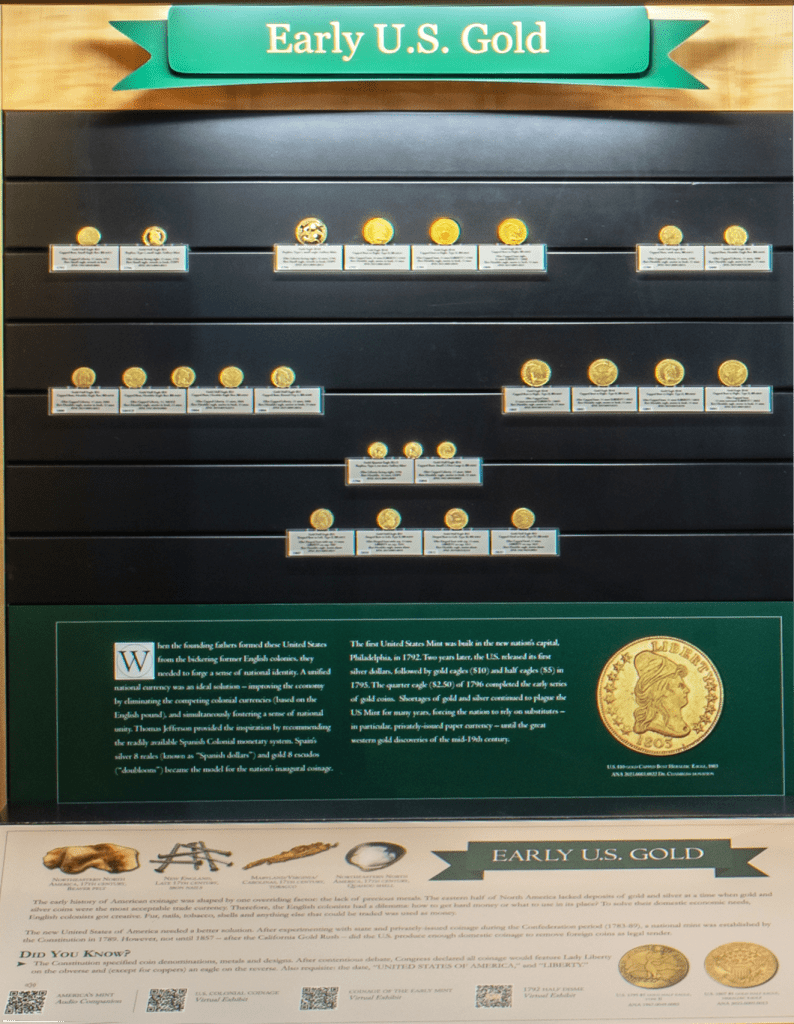
Colonial Currency
Paper money has a unique place in U.S. history. British North America’s lack of silver and gold, combined with English export restrictions on bullion and coins, forced colonists to get creative. At one time or another, tobacco, nails, beaver pelts, and other commodities were all used as alternative forms of money. In 1690, the Massachusetts Bay Colony authorized the first paper money in North America – the first issued by any government in the West! Other colonies soon followed suit. Despite British attempts to suppress its use, colonial currency became commonplace by necessity.
At the start of the American Revolution, Congress issued new Continental Currency to pay for the war. “Continentals” were denominated in Spanish dollars, the most commonly available hard currency, but without the monetary reserves to back it, their value relied on patriotism alone. Further complicating matters, the independent states issued their own, independent currencies, as well, each with their own denominations and exchange rates. To alleviate confusion, the Constitution stripped the States of their right to issue legal tender currency in 1792. Choose a case below to begin exploring the exhibit.
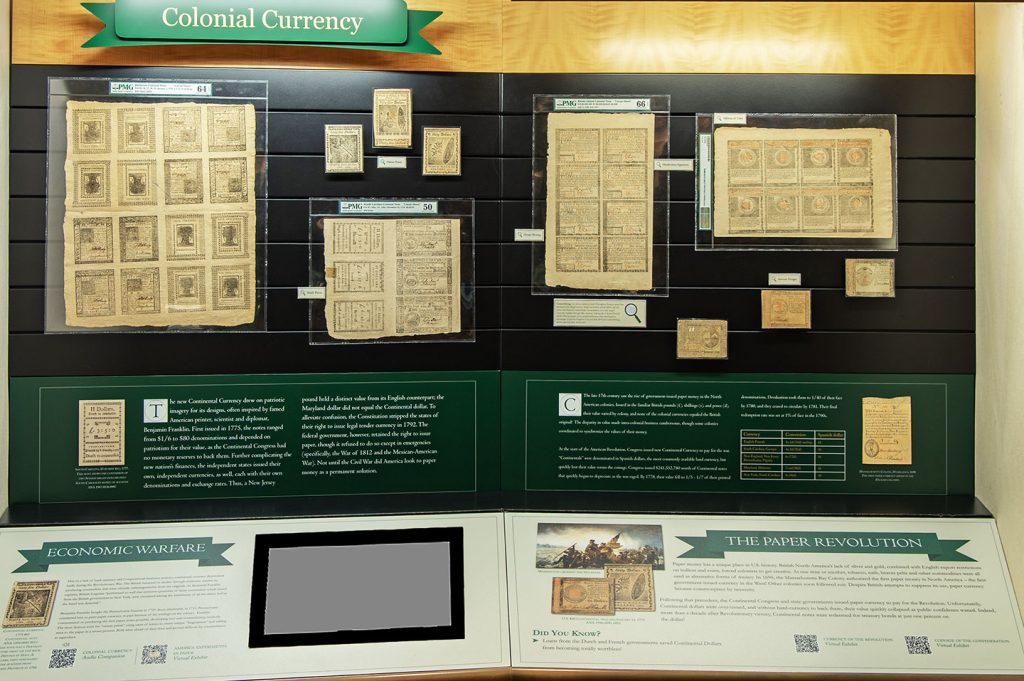
America’s Gold Rush
Contrary to legend, the first American gold rush didn’t begin in California. It actually started in North Carolina and quickly escalated after a major gold strike near Dahlonega, Georgia in 1828. Excitement and able-bodied men followed the gold from Georgia to California to Colorado, and later to North Dakota and Alaska. Unprecedented sources of silver in Nevada and Colorado added to the mining frenzy that finally made the United States self-sufficient in precious metals.
America’s gold rushes all occurred in relatively unpopulated areas, poorly equipped to handle large numbers of prospectors. Hoping to strike it rich, they arrived by the thousands, only to find shortages of supplies and, ironically, money. The shortage of coins, and consequently the purchasing power of these hopeful “goldbugs,” led entrepreneurial private minters and assayers to join the migration. They quickly set up shop, converting the raw gold into ingots and private coins. In denominations ranging from $5 to the massive $50, 2.5 ounce “slugs,” privately struck coins were eagerly accepted, as long as manufacturers maintained consistent purity and weight, until 1862 when the Territory of Colorado became the last region to ban private coin production. Choose a case below to begin exploring the exhibit.
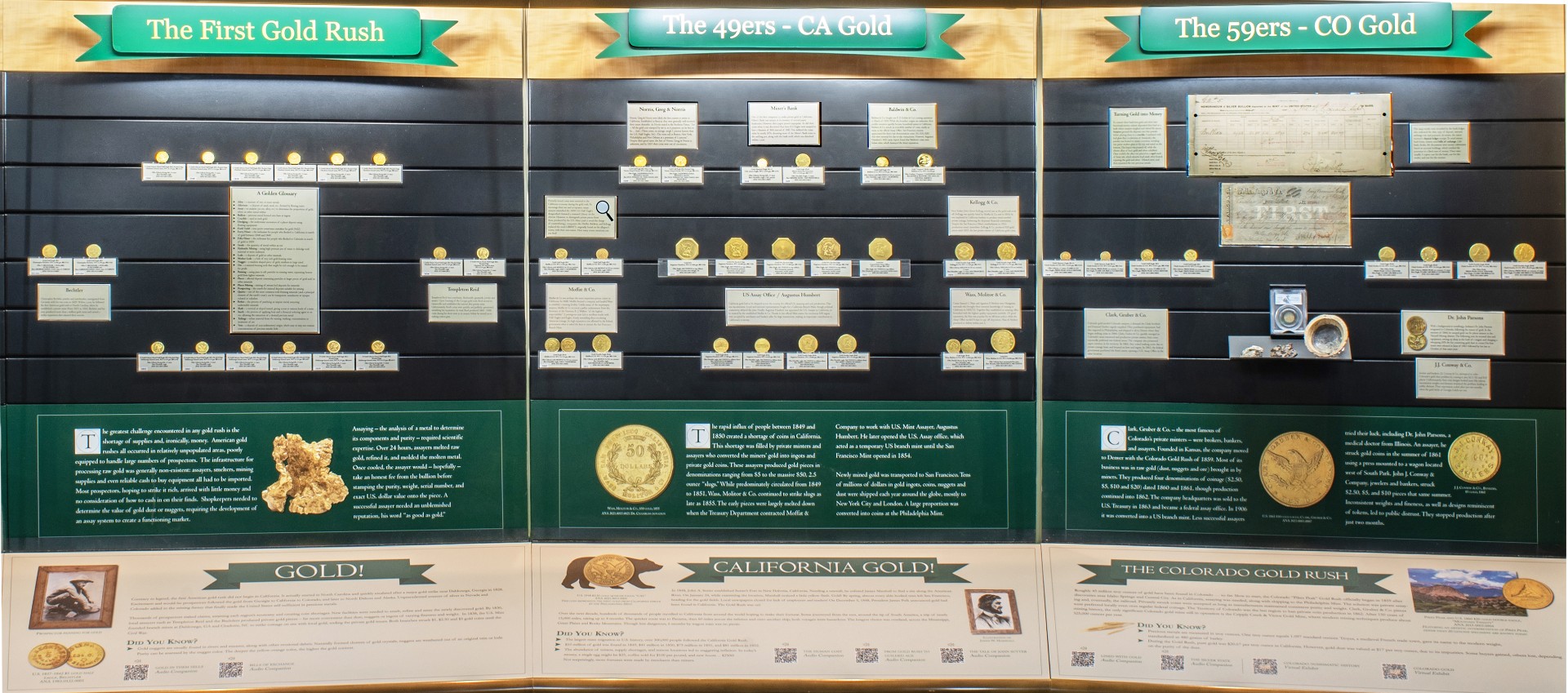
Money of the Civil War
A War Fought with Paper
The Civil War (1861-1865) was a defining experience for American history and currency. Financing war is problematic for governments and causes huge economic challenges – doubly so in a Civil War. The Federal and Confederate governments realized that extraordinary efforts were required to raise funds for the armies fighting the war. Over four years, American money was forged under pressure until, like the nation, it emerged profoundly changed.
Civil War Tokens
As fighting broke out, gold and silver were hoarded almost immediately, making coinage of any denomination scarce. Merchants needed a substitute currency to keep trade going: tokens, mostly made of copper. By 1864 more than 25 million tokens had been minted. Representing 23 states, they underscore the multitude of places and people touched by the American Civil War. Choose a case below to begin exploring the exhibit.
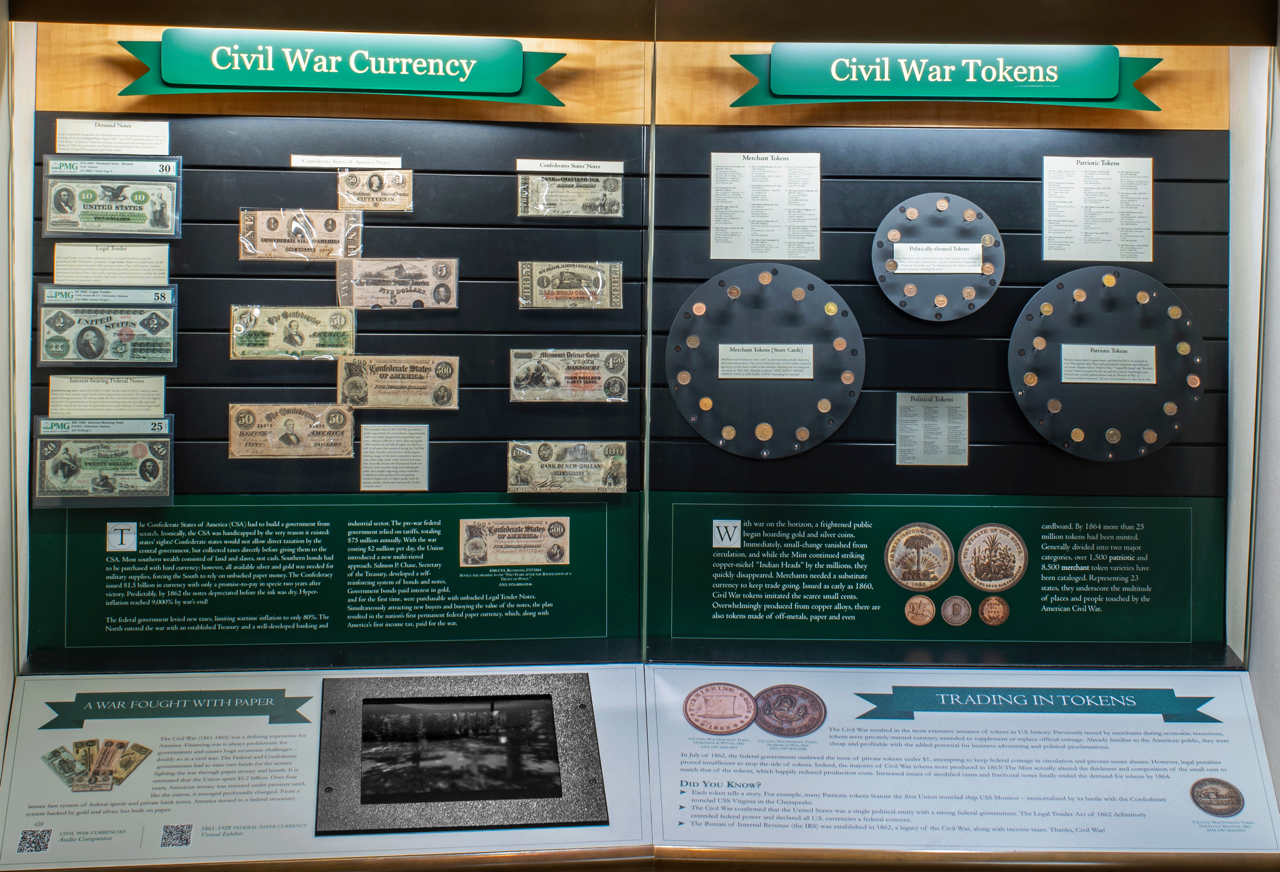
The Bebee Collection: An Evolution of American Paper Currency
Paper money was not an instant success. On the contrary, the evolving nature of U.S. banknotes portrays the American struggle for economic stability. Featuring rare uncut sheets of Silver Certificates, Fractional Notes, National Bank Notes and Federal Reserve Bank Notes, the remarkable Bebee Collection tells America’s revolutionary story as it grappled with an unprecedented reliance on paper currency. From a laissez fare system of federal specie and private bank notes, America transformed into a federal monetary system backed by gold and silver, but built on paper.
Aubrey & Adeline Bebee
In 1987 Aubrey and Adeline Bebee donated their extensive collection of US paper currency to the ANA. During the previous half-century, Aubrey Bebee – collector, dealer and ANA life member 110 – along with his wife, Adeline, assembled a world-class collection of coins, paper money and numismatic books. Among their many accolades, the Bebees received the Farran Zerbe Memorial Award in 1988 and the ANA Lifetime Achievement Award in 1992. In 1996, Aubrey was inducted into the ANA Numismatic Hall of Fame. Choose a case below to begin exploring the exhibit.
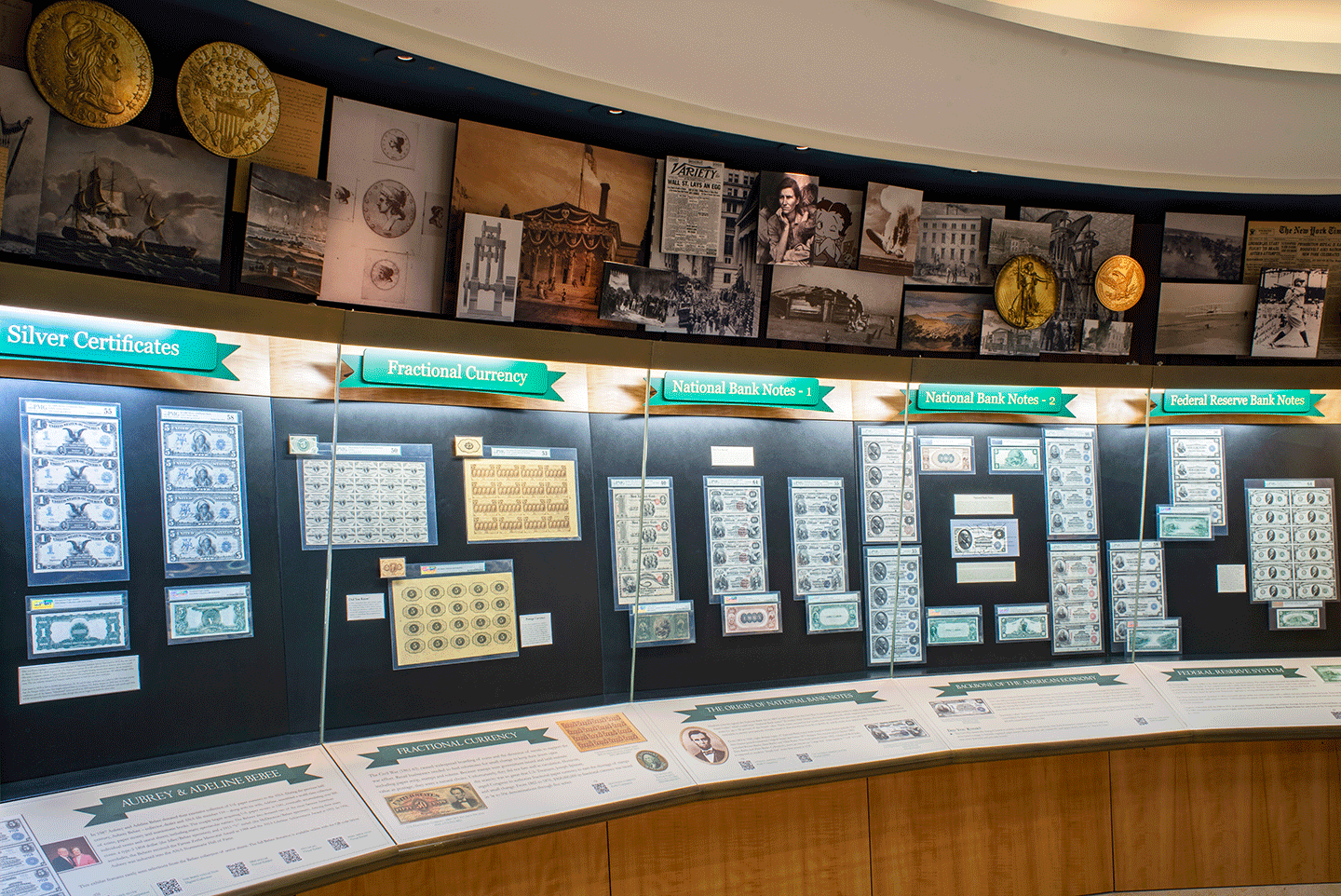
The Markoff Presidential Collection
In 1979 Elliot Markoff donated his custom-made numismatic collection of American presidential history. Markoff, who immigrated to the United States from Poland, enthusiastically studied American history and collected American coins. Eventually, he decided to create an exhibit using coinage to honor America’s presidents. Each snapshot of history features a portrait from the Bureau of Engraving and Printing, an autograph, and coins from the years of birth, inauguration(s) and death. An exciting means to view numismatic history, the included coins, often rare, are placed within their historical context and illustrate the period during which the presidents lived. Choose a case below to begin exploring the exhibit.
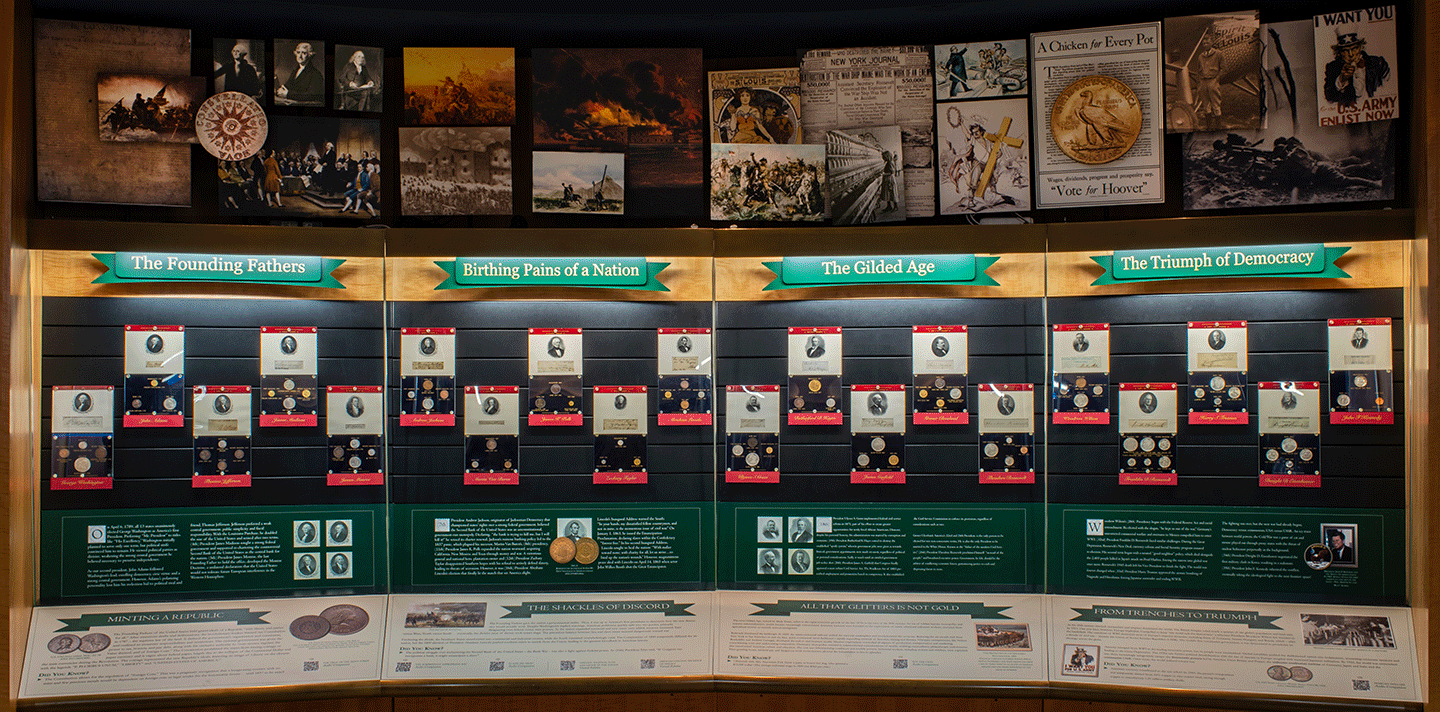
Classic Commemorative Coins
Commemorative coins are minted in remembrance of a particular historic event or noteworthy individual. The United States has told American history through commemorative coins since 1892 with a half dollar minted for the World’s Columbian Exposition of 1893. Financially, Classic Commemoratives are legal tender, however, sold at a premium, they are not meant for circulation. Over 62 years, the Classic Commemorative series expanded to celebrate 53 different events, occasions or individuals in silver and gold coins. Their denominations range from the 25-cent Isabella quarter (1893) to the $50 Panama-Pacific gold pieces (1915).
From their inception, American commemorative coins honored important events and provided interesting keepsakes, while their proceeds helped offset costs and raise funds for various organizations. Though authorized by Congress, the sponsoring group purchased their Commemoratives at cost, and were responsible for selling them (at a premium) to the public with proceeds benefiting their cause. While some were extremely popular, many fell short of expectations, and the unsold coins were often returned to the Mint for melting. Thus, the least popular coins are sometimes the rarest.
Generations of numismatists, fueled by the excitement of the hunt, have sought and collected commemorative coins for their rarity, their local affiliations, and their historical value. Choose a case below to begin exploring the exhibit.
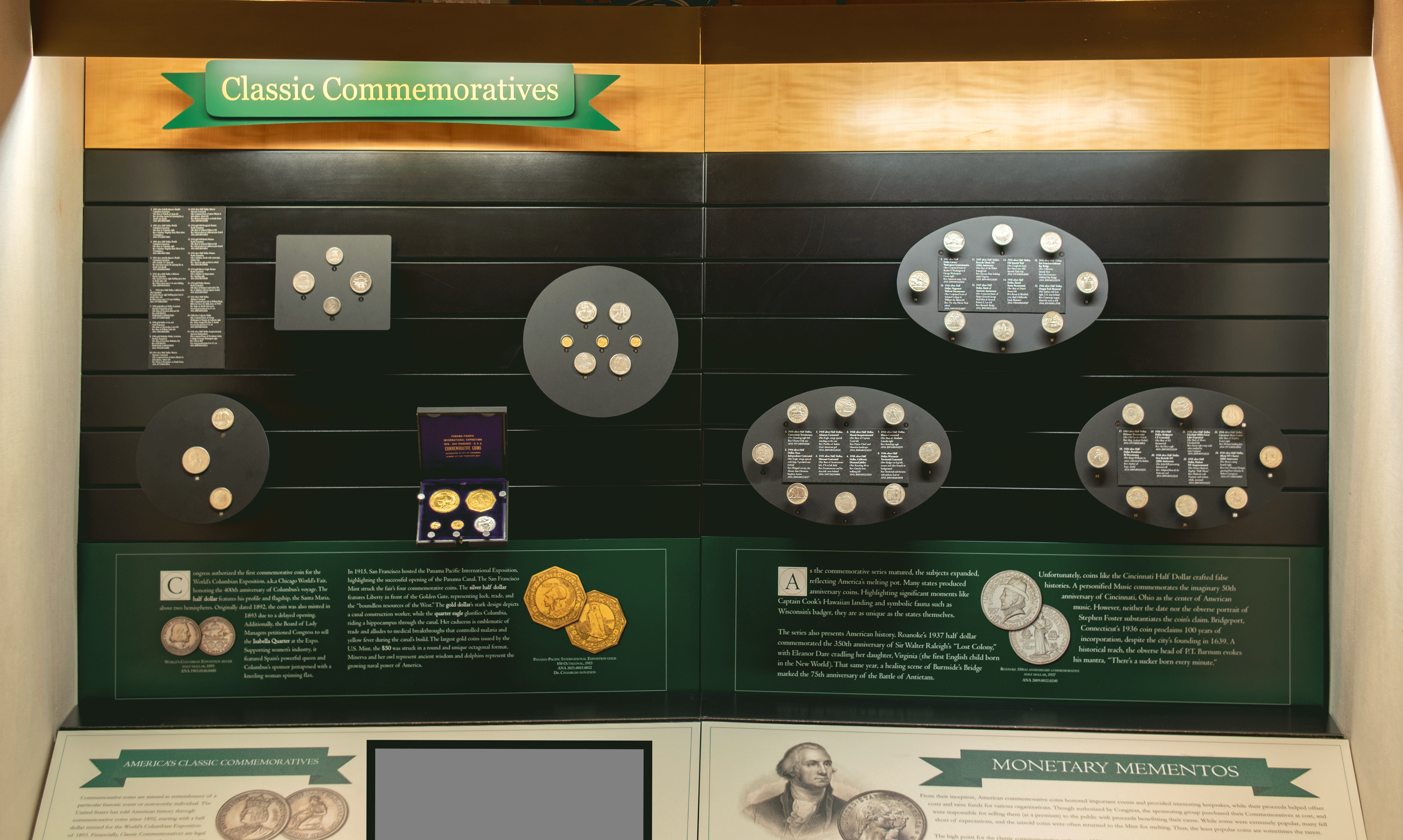
The Baker-Manley Collection of Washingtonia
Washington: Pater Patriae
Military hero, statesman, surveyor, Founding Father, President – George Washington was involved at every stage of America’s founding. His decisions and pragmatism helped form these United States. Yet, while he was entrusted with great power – nearly unlimited control during the Revolutionary War – he freely relinquished it after victory. Though many implored him to accept permanent political power, Washington adamantly refused. Personifying the American ideal, he became a symbol of freedom and democracy around the world, and today, his image and name represent the union for which he fought.
The Baker-Manley Collection
Countless medals and tokens celebrate his enduring legacy, and the Money Museum is privileged to have the ultimate grouping of numismatic Washingtonia pieces. The Baker-Manley collection was donated to the American Numismatic Association by Dwight Manley, an ANA-life member and benefactor. Over 950 items, the core of this collection was formed by William Spohn Baker (1824-1897), the first numismatist to write a comprehensive catalog of George Washington related materials. Choose a case below to begin exploring the exhibit.
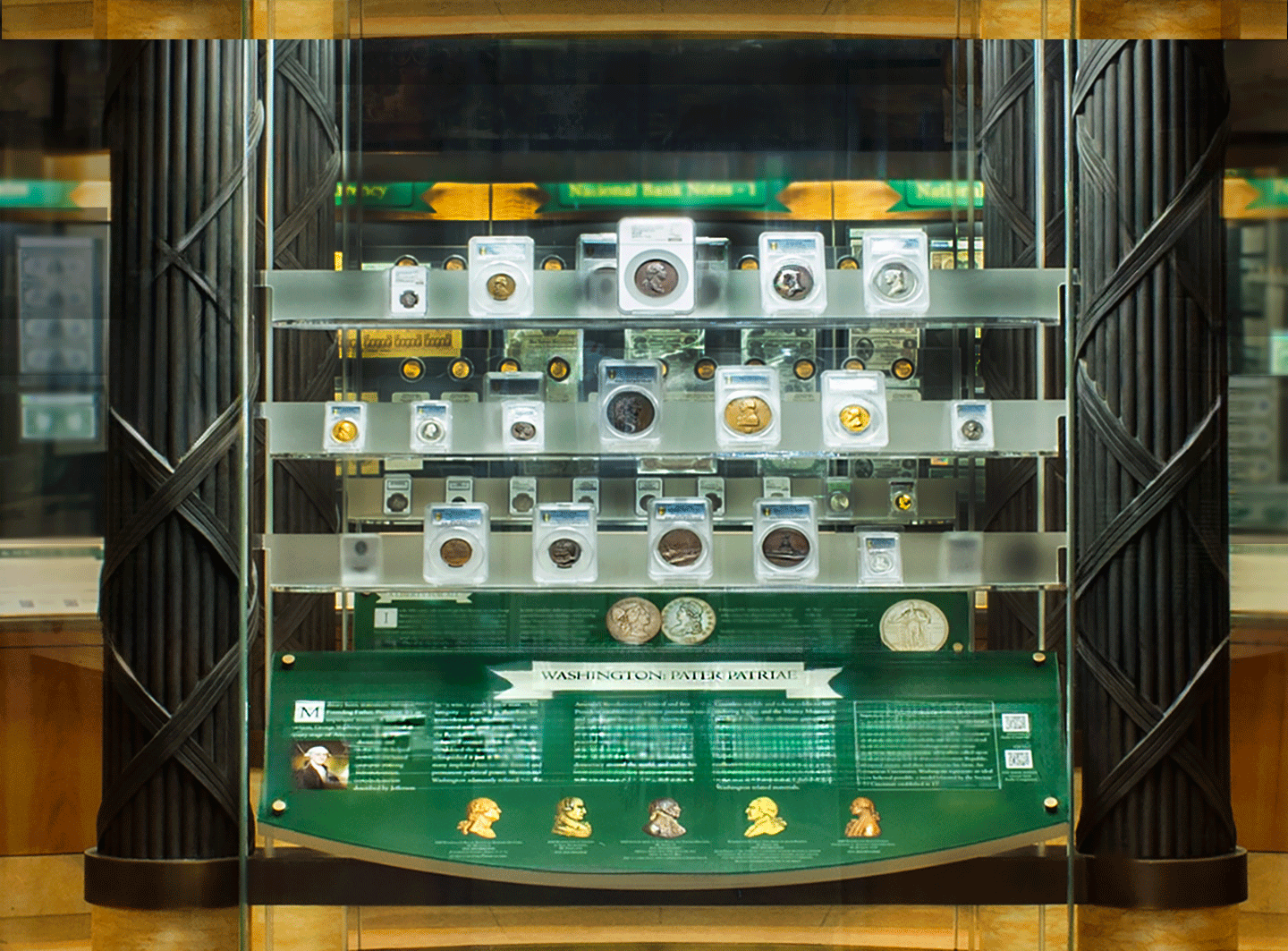
The Renaissance of American Coinage and Progression of Liberty
At the turn of the 20th century, President Theodore Roosevelt eloquently described American coins as “atrocious hideousness.” Determined to create a majestic coinage worthy of this great nation, Roosevelt implored renowned sculptor, August Saint-Gaudens, to help shape a “Renaissance of American Coinage” that would revive the beauty and power of ancient Greek coins through a modern artistic lens.
A Liberty for All
In the 18th century, only monarchs put their likenesses on coins. Conversely, George Washington believed the American Republic should emphasize ideals, not individuals. Therefore, after heated debate, the 1792 Coinage Act mandated an “impression of liberty” on coins. Mint Director, Robert Scot, fashioned the first personification of Liberty, but his allegory was quickly replaced by another and then another. As America and its citizens evolved, so, too, did their “Lady Liberty,” ever-reflective of America’s progress and fight for freedom. Choose a case below to begin exploring the exhibit.
